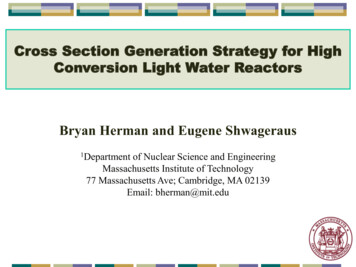
Transcription
Cross Section Generation Strategy for HighConversion Light Water ReactorsBryan Herman and Eugene Shwageraus1Departmentof Nuclear Science and EngineeringMassachusetts Institute of Technology77 Massachusetts Ave; Cambridge, MA 02139Email: bherman@mit.edu
OutlineHigh Conversion Water ReactorsCross Section Homogenization ProcessBranch CasesApplication of Discontinuity FactorsConclusions/Future WorkSerpent Wish List
High Conversion Water ReactorsParfait coreAxial blankets are used to achieve BR 1.01Blankets: Depleted or Natural UraniumFissile zones: TRU (Pu MA) MOXExamples: Hitachi – Resource Renewable BoilingWater Reactor (RBWR) JAEA – Reduced Moderation Boiling WaterReactor (RMWR)
Hitachi RBWRAssemblies are axially heterogeneousCore average void fraction 60% Upper Reflectorvs. typical BWR 40%Upper BlanketFissile zones produce neutrons whileblanket zones absorb themUpper FissileInternal BlanketLower FissileSignificant axial streaming of neutronsLower BlanketLower Reflector
Cross Section HomogenizationSerpentPARCS
Obtaining Homogenized XSPARCS solves multi-group diffusion eq.: 𝐷𝑔 𝜙𝑔 Σ𝑎𝑔ℎ 𝑔𝜐Σ𝑠 𝜙ℎ𝜙𝑔 𝜐Σ𝑠𝑔 𝜙𝑔 ℎleakageinteractions𝜒𝑔 𝑘𝑒𝑓𝑓𝜈Σ𝑓,ℎ 𝜙ℎℎscattering production fissionw/ (n,xn) production productionmacroscopic cross sections are flux weighted:Σ𝛼𝑔 𝐸𝑔 13 𝑟 Σ 𝑟, 𝐸 𝜙𝑑𝐸𝑑𝛼𝐸𝑔𝑉𝐸𝑔 13 𝑟 𝜙 𝑟, 𝐸𝑑𝐸𝑑𝐸𝑔𝑉𝑟, 𝐸
Monte Carlo Estimation of DDiffusion coefficient must be current-weighted Usually it is just flux-weighted and a B1 calculationis performed to adjust itFor RBWR we would like to have directionaldiffusion coefficientsInstead we use discontinuity factors topreserve neutron balance
PARCS Overall MethodologySerpentSerpentXSPARCS
Branch CasesMust account for a range of operating conditions unknown beforehandCross sections are therefore parameterized overinstantaneous values and time-averaged (history)operating conditionsInstantaneous conditions – control rod, poison conc.,coolant density, fuel temp, coolant tempHistories – burnup, control rod, density
SerpentXS Code
PWR Test ProblemReference GeometryBranchIndxCRRefer.CRDC lowDC highTF lowTF .707Power DistributionRodded GeometryPC[pcm]100010001000100010001000TF [K] TC [K]9009009009005821500582582582582582582
Reference Case
Fuel Temperature Branch
2-D vs. 3-D Generated XSStrong axial material discontinuitiesObtain XSs generated in conventional 2-Dgeometry (denoted as 2-D XSs) Surrounded by zero-net current boundariesCompare to XSs generated for axial zonessurrounded by neighbors (denoted as 3-DXSs)Serpent makes this relatively simple
2-D vs. 3-D XSHomogenizeHomogenize2-D3-D
Fissile-Fissile Two-Zone Results2-D:Keff 1.559003-D:Keff 1.55913Keff 1.55908
Fissile-Blanket Two-Zone Results2-D:Keff 1.377333-D:Keff 1.38312Keff 1.36620
Axial Discontinuity FactorsUB2K-eff: 1.36620UF2Two-Zone ProblemPARCS (No ADFs):K-eff: 1.38312Get Homogeneous FluxJJ
Discontinuity factors: BackgroundReal flux has to be continuousHomogeneous flux does notADF: Ratio of heterogeneous-to-homogeneous surface fluxConventional process: 2D reflected assembly Homogeneous surface flux nodal flux Surface current is zero NOT the case in RBWR
Procedure for toy problemsObtain the heterogeneous solution with Serpent Global reflective boundaries,Extract homogenized parameters from SerpentCompute interface currents using neutron balancePerform fixed source 1D diffusion calculation for each coarseregionCompute discontinuity factors using surface fluxes: Heterogeneous (Serpent)Homogeneous (Fine mesh 1D diffusion)Run the entire homogeneous geometry (1D diffusion ADFs) To verify that homogeneous and heterogeneous setups are equivalent
Axial Discontinuity FactorsDiscontinuity Factorsf1UF 1.028f1UB 0.966f 2UF 0.972f2UB 1.034PARCS (ADFs):K-eff: 1.36620
The need for surface currenttallies To generate the exact discontinuity factors (e.g. inreflector) surface currents are neededHomogeneous flux is determined from fixed sourcediffusion equation with current boundary conditionsCurrently we use global reflective boundaryconditions to back out surface currents using neutronbalance
2-G Single AssemblyCalculations
12-G Single AssemblyCalculations
Approximation of ADFsCan we get away with just homogenizing overtwo-zone problems
ConclusionsObserved large differences between Serpent andPARCS calculations using conventional approachNeed to treat axial discontinuity for RBWR core Current methods are not appropriateDeveloped methodology to generate cross sectiondatabase for PARCSShowed applicability of axial discontinuity factors
Future WorkFinish developing methodology for axial discontinuityfactorsStudy sensitivity of discontinuity factors for differentoperating conditionsApproximate discontinuity factors with: Single Assembly Full Core
Serpent “Wish List”Surface current tallies (a must)A parallel calculation method that reproducesanswers w/ arbitrary number of CPUsBuilt-in method to restart calculations and perturbconditions (like in CASMO)Output fission product yields (I, Xe, Pm)Pin power and flux distribution per energy group
Acknowledgments Thesis supervisors Prof. Eugene Shwageraus Prof. Ben Forget Prof. Mujid Kazimi Prof. Smith for discontinuity factors Prof. Downar (UMich) for PARCS Dr. Jaakko Leppanen (VTT Finland) for Serpent Rickover Fellowship
ReferencesDownar, T., Lee, D., Xu, Y., and Seker, V. (2009). PARCS v3.0: U.S. NRC Core NeutronicsSimulator. User Manual. University of Michigan.Leppänen, J. (2007). Development of a New Monte Carlo Reactor Physics Code. PhD thesis,Helsinki University of Technology.Smith, K. S. (1980). Spatial Homogenization Methods for Light Water Reactor Analysis. PhD thesis,Massachusetts Institute of Technology.Stalek, M. and Demazière, C. (2008). Development and validation of a cross-section interface forPARCS. Annals of Nuclear Energy, 35:2397–2409.Takeda, R., Miwa, J., and Moriya, K. (2007). BWRs for Long-Term Energy Supply and forFissioning almost all Transuraniums. Boise, Idaho. Proc. Global 2007.Xu, Y. and Downar, T. (2009). GenPMAXS-V5: Code for Generating the PARCS Cross SectionInterface File PMAXS. University of Michigan.
Questions
Spatial Homogenization Methods for Light Water Reactor Analysis. PhD thesis, Massachusetts Institute of Technology. Stalek, M. and Demazière, C. (2008). Development and validation of a cross-section interface for PARCS. Annals of Nuclear Energy, 35:2397–2409. Takeda, R., Miwa, J., and Mo











